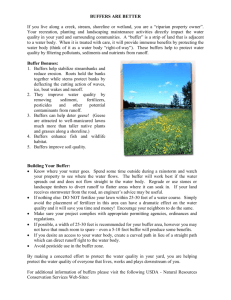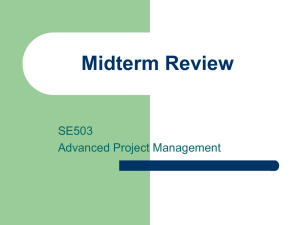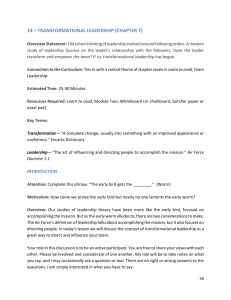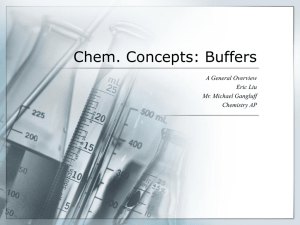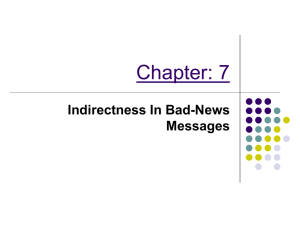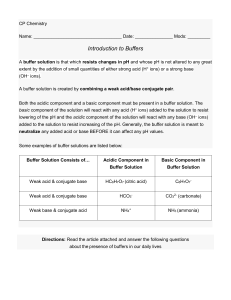View Presentation
advertisement
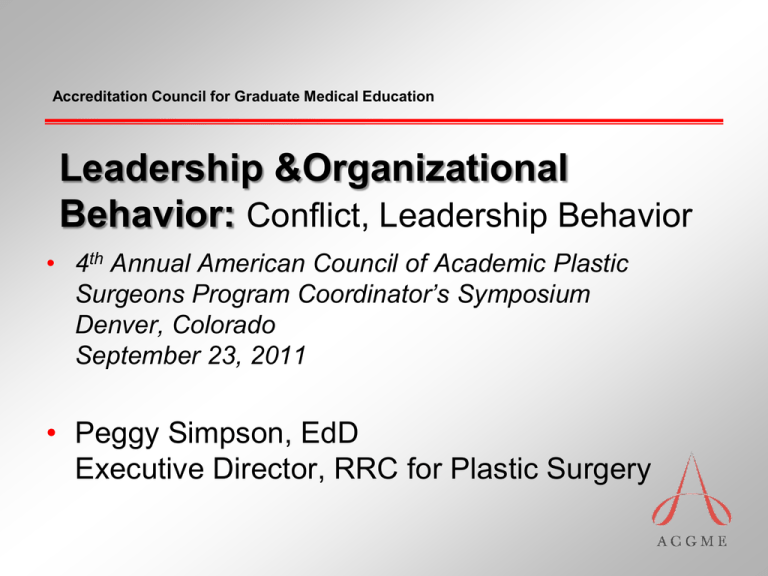
Accreditation Council for Graduate Medical Education Leadership &Organizational Behavior: Conflict, Leadership Behavior • 4th Annual American Council of Academic Plastic Surgeons Program Coordinator’s Symposium Denver, Colorado September 23, 2011 • Peggy Simpson, EdD Executive Director, RRC for Plastic Surgery Agenda • Leader Behavior • Conflict • Communicating Negative News Leader Behavior • Leadership • Power What are leadership and management? • Leadership • Process of influencing others to understand and agree on what needs to be done and how to do it; and • Process of facilitating individual and collective efforts to accomplish shared objectives. What are leadership and management? • Role of management is to promote stability or to enable the organization to run smoothly. • Role of leadership is to promote adaptive or useful changes. What are leadership and management? Formal leadership Exerted by persons appointed (or elected) to positions of formal authority in organizations. Informal leadership Exerted by persons who become influential because they have special skills that meet the resource needs of others. What are inspirational leadership perspectives? • Transactional leadership •Involves leader-follower exchanges necessary for achieving routine performance that is agreed upon by leaders and followers. •Uses contingent rewards to motivate followers. •Identifies what must be done to accomplish the desired results. •Uses corrective action only when goals not met. •Laissez faire style – avoids making decisions. What are inspirational leadership perspectives? • Transformational leadership • Leaders broaden and elevate followers’ interests, generate awareness and acceptance of the group’s mission, and stir followers to look beyond selfinterests. What are inspirational leadership perspectives? • Dimensions of transformational leadership • • • • Charisma Inspiration Intellectual stimulation Individualized consideration What is moral leadership? • Transformational Leadership • Affects followers by positively impacting their goals and beliefs through vision and values, and intellectual stimulation. Power • Power is the ability to get someone else to do something you want done or the ability to make things happen or get things done the way you want. Power Bases • Position power –power based on one’s formal position in an organization. These include: • Personal power – resides in the individual and is independent of the position the individual holds. What are the key sources of power and influence? TYPES OF POSITION POWER Legitimate Reward Coercive Process Information Representative Types of Personal Power Expertise Derived from having knowledge, experience, or judgment that is valued and needed by others. Rational Persuasion Ability to control another’s behavior by presenting facts and logical argument that will result in positive outcomes. Reference The ability to control another’s behavior because the person wants to identify with the power source. Coalition Ability to control another’s behavior indirectly because of a reciprocal obligation to you or the larger group. What is the nature of conflict in organizations? • Conflicts are disagreements that occur in social situations. • Substantive • A disagreement over goals, and the means for their accomplishment. • Emotional • Interpersonal difficulties that arise over feelings of anger, mistrust, dislike, fear, and resentment. What is the nature of conflict in organizations? • Functional conflict • Results in constructive, positive benefits to individuals, the group, or the organization. • Dysfunctional conflict • Destructive to an individual or team. What is the nature of conflict in organizations? • Potential benefits of functional conflict • Surfaces important problems so they can be addressed. • Causes careful consideration of decisions. • Increases information available for decision making. • Provides opportunities for creativity. How can conflict be managed? Perceived conflict • When the antecedents become the basis for substantive or emotional differences between people or groups. Felt conflict • Conflict experienced as tension that motivates the person to take action to reduce feelings of discomfort. How can conflict be managed? • Manifest conflict • Conflict can be manifested in actual behaviors that attempt to remove or correct conflict antecedents. • Failure to resolve antecedents results in suppression of the conflict - only to re-emerge at a later time, or in another form. How can conflict be managed? Causes of conflict • Vertical conflict • Occurs between hierarchical levels. • Horizontal conflict • Occurs between persons or groups at the same hierarchical level. • Line-staff conflict • Involves disagreements over who has authority and control over specific matters. How can conflict be managed? Role ambiguity conflicts • Occur when the communication of task expectations proves inadequate or upsetting. Workflow interdependencies • Occur when people or units are required to cooperate to meet challenging goals. Domain ambiguities • Occur as misunderstandings over such things as customer jurisdiction or scope of authority. How can conflict be managed? • Resource scarcity • When resources are scarce, working relationships are likely to suffer. • Power or value asymmetries • Occur when interdependent people or groups differ substantially from one another in status and influence or in values How can conflict be managed? Indirect strategies: Reduced interdependence • Adjusting the level of interdependency among units or individuals when workflow conflicts exist • Decoupling, buffering, and linking pin strategies address specific organizational situations. How can conflict be managed? • Appeal to common goals • Focusing the attention of potentially conflicting parties on one mutually desirable conclusion. • Hierarchical referral • Problems are referred up the hierarchy for more senior managers to reconcile. • Altering scripts and myths • Superficial management of conflict by using behavioral routines that become part of the organization’s culture. Direct Conflict Handling Styles Cooperative Accommodating Unassertive Collaborating Compromise Avoiding Competing Uncooperative Assertive How can conflict be managed? • Lose-lose conflict • Nobody gets what he or she wants; underlying reasons remain unresolved. Strategies include: • Avoidance. • Accommodation- playing down differences. • Compromise- giving up something valued. How can conflict be managed? • Win-Lose conflict • One party achieves its desires at the expense and to the exclusion of the other party’s desires. • Competition - force, skill, or domination • Authoritative command – quick and decisive How can conflict be managed? • Win-Win conflict • Achieved by a blend of both high cooperativeness and high assertiveness. • Collaboration or problem solving – Stresses gathering and evaluating information in solving disputes and making choices. Communicating Negative News Negative Message Primary Purposes • Give the audience bad news. • Have the reader read, understand, and accept the message. • Maintain as much goodwill as possible. Negative Message Secondary Purposes • Build a good image of the sender. • Build a good image of the sender’s organization. • Reduce or eliminate future correspondence on the same subject. Negative Messages for Customers • Give the reason for the refusal before the refusal itself when readers will understand and accept the reason. • Give the negative just once, clearly. • Present an alternative or compromise, if one is available. • End with a positive, forward-looking statement. Alternatives in Negative Messages • Offer the audience another way to get what he or she wants. • Suggest that the sender really cares about the reader. • Enable the audience to reestablish psychological freedom. • End on a positive note. Negative Messages to Superiors • • • • • For negative messages to superiors Describe the problem. Tell how it happened. Describe the options for fixing it. Recommend a solution and ask for action. Negative Messages to Subordinates • • • • For negative messages to subordinates Describe the problem. If possible, ask for input or action. Present an alternative or compromise, if one is available. Types of Buffers • Start with any good news or positive elements. • State a fact or provide a chronology of events. • Refer to enclosures (if written). • Thank the audience for something he or she has done. • State a general principle. What are the most common kinds of buffers? • Start with any good news or positive elements the letter contains • State a fact or provide a chronology of events, refer to enclosures in the letter • Thank the reader for something he or she has done, and state a general principle Rejections and Refusals • Outside the organization, try to use a buffer. • Give an alternative if one is available. • Politeness and length will help. • When internally, • use your knowledge of the individual and organization to craft your message. Using positive emphasis in negative messages • At the sentence level, avoid unnecessary negative words and phrases and hidden negatives • Negative message must still be understood by the reader • If possible, give an alternative or compromise • Use a buffer if the audience expects or appreciates one • Use a goodwill ending where possible Deciding to give the negative directly or to use a buffer • When direct patterns seem too blunt, writers can consider using a buffer. • Buffers act as a barrier/cushion to the bad news • Buffers are neutral or positive statements allowing the writer to delay the negative. • Research suggests buffers may, in fact, not work • Consider audience when deciding on using a buffer.

